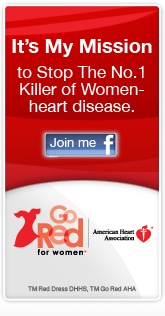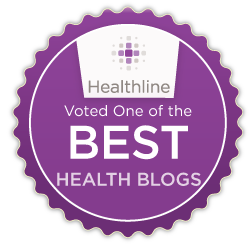I was asked to speak at a United Hospital Foundation event celebrating American Heart Month and to share my “patient story.” The annual event, “Celebrating the Hearts of Women” focuses on women’s heart health and prevention, and was held February 22. I was nervous, but it went well, and I made it through without crying (too much).
I thought you might like to read my speech, so I’ve pasted it below. If you have read along with me on this blog these last few months, some of it will sound familiar.
Today I’d like to start with a story about Mary Jean. Mary Jean leaned over to talk to me as I waited for my first cardiac rehab orientation on a sunny Monday last August.
“Will you be joining us?” she said.
“Yes,” I said. “I had a heart attack last Sunday, and I left the hospital on Wednesday.”
“Oh,” she said, and paused. I didn’t wait for her to ask what I guessed was coming.
“I’m 37.”
She didn’t say I was too young to have a heart attack, or even act that shocked or surprised. She told me that she was 86, had had bypass surgery and now had a new valve and a pacemaker. And then she said, “You’ll like it here. The people are very nice.”
They were nice, and I did like it. The effort was lighter than I was used to, since I’d been training all summer for the Twin Cities Marathon and two duathlons.
But it was exercise and movement and it felt good. I was supervised, monitored, checked, and scored. Someone told me what to do, when, for how long, and at what intensity. After the shock and upheaval I’d just been through, it was perfect.
I was in the 3 p.m. group on Monday, Wednesday, and Friday. When I got there it seemed everyone knew each other; they had obviously been together for weeks. There were three men and one other woman. They were all at least two decades older than me.
The first day I just got a couple smiles and some strange looks. It wasn’t until the second day, while on side-by-side recumbent bikes, that Patrick, a dapper gentleman who’d had a valve replaced 9 weeks earlier, leaned over and said, “You were cruisin’ pretty good there on the treadmill.”
I shrugged and smiled.
“Well, I was a runner until about a week ago,” I said.
“You didn’t have heart surgery did you?” Patrick asked.
“Yes, I had a heart attack and now I have a stent.”
“But you’re too young!” he said.
“Yep, but I’m the poster child for it can happen to anyone.”
Obviously and unfortunately I am not too young and neither are the many others like me. I saw this fact on a poster in the heart clinic: “62% of all people living with heart disease are under 65.”
A few minutes later Patrick asked me if my heart attack symptoms were indeed different because I’m a woman. I started telling him my story, and soon it was the whole group, quietly listening, mostly in disbelief – which by now, I recognize as a very common reaction.
I told them that the pain started Friday (maybe even Thursday, if I’m honest about it) and I took Advil by the handful and explained it away for two or more days. I must have hurt myself showing off yoga poses for my kids, I thought. Maybe it’s heartburn? I probably just need more sleep.
I told them that it hurt in my back, between my shoulder blades and then spread to both arms and shoulders, even to the palms of my hands.
I said that on Saturday night I popped Tums and Advil alternately and propped myself up on the couch all night, actually whimpering in pain, but still I didn’t call 911 or even wake up my husband. That it wasn’t until Sunday morning when I broke out in a cold sweat did I realize there might be something more wrong with me than I could fix on my own.
You might imagine I might have called 911 then.
Nope.
I ate breakfast, helped pack for camp, took a shower, styled my hair, supervised a preschooler potty break, and put on makeup and then . . . drove myself to the hospital, while I waited patiently in line to fill out my triage forms. We women don’t want to be a bother, you know.
At least I wasn’t the only one puzzled. In the ER, every test save one came back normal. Normal blood pressure, normal pulse, normal EKG, normal X-Ray, normal CT, normal echocardiogram. They gave me nitrogen and nitrogen patches and it didn’t dent the pain.
The only sign to go on was the cardiac enzyme test, and it was those positive and escalating results that landed me in the cath lab for an angiogram. It was only after the surgery was over – blockage removed, stent installed – did I learn I had had a heart attack.
The pain didn’t subside for another 8 hours, and I spent Monday in the ICU. By Tuesday I was walking stairs (I’ve never climbed a harder 6 stairs in my life), and by Wednesday evening I was home with a dozen new prescriptions and an appointment for cardiac rehab.
And so I began my new life with heart disease.
I’m still me. I’m a mom of two boys. A wife and daughter. A distance runner. A friend and colleague. But I’m a different me, and I’m still getting to know her. Your life does change if you have heart disease. And my life has changed for the better.
Heart disease is the number one killer of women in this country. Number. One. It kills more women than the next four diseases combined, including all forms of cancer. But it didn’t kill me, and I want to use my story to raise women’s awareness of their risk for heart disease. I want to learn as much as I can. I want to make the changes necessary to keep myself safe.
With no risk factors save a family history of high cholesterol, I thought I knew enough to stay safe. I didn’t, but you should.
For example, did you know:
- That more than 1 in 3 adult American women has some form of cardiovascular disease?
- That the biggest risk factors for heart disease are high cholesterol, high blood pressure, obesity, diabetes, smoking, and family history?
- That 42% of women who have a heart attack will die within a year, compared to 24% of men?
- That women’s hearts respond better than men’s to healthy lifestyle changes?
- That 80 percent of cardiac events could have been prevented through healthier choices?
If you knew these facts and knew your own risk, would you make the changes necessary to protect your heart? Would you:
- Talk to your doctor and get a lipid profile to check your cholesterol levels? Think of it this way. You get your mammogram and Pap smear every year. Add lipid profile to that list. You are at a far greater danger of heart disease than you are of breast or cervical cancer.
- Know your Body Mass Index and lose weight if you need to?
- Exercise? That should go without saying, but it in this country unfortunately it doesn’t.
- Know if your blood pressure is high and take steps to improve it?
- Stop smoking?
- Make sure your doctor knows if you have a family history of heart disease or high cholesterol?
Learning and knowing and changing and acting is very empowering. It gives me a sense of control and peace of mind – the two things you lose first when knocked down and out with a life-threatening disease.
I started a blog I called My Life, in Red to keep track of what I was learning and to post updates to family and friends. When other survivors started finding it and reading it gave the blog purpose and meaning and sometimes, moves me to tears.
I finished rehab and joined Exercare. I had learned in rehab that I love being told what to do so now I work out with two trainers. It isn’t lost on me that all the trainers and staff are medically educated, or that most of my fellow members are heart patients too. When one day I asked a nurse about some symptoms in what I thought was a casual way, and the next day both my trainers sat me down for a talk about it, I knew I was being cared for far beyond core strength and weight loss. And when the locker room conversations are about how to time your meds if you are going out for New Year’s Eve, I know I’m in the right place.
I take 12 pills a day, including an antidepressant. I’m not the least bit private about that, because I really want people to know the risks of heart disease and depression. More than half of all heart attack survivors become depressed and women – particularly younger women – are at an even greater risk. What’s worse is that people with post-heart attack depression are 2 to 3 times more likely to have another heart attack. So I take my 12 pills. Gladly.
I haven’t eaten butter since August. Or alfredo. Or frosting. After a while you really don’t miss them, and with olive oil and avocados and red wine on the heart-healthy list, I really don’t feel deprived.
And just last week I signed up for the 2012 Twin Cities Marathon. I’ve done it before, but this time I have something to prove. I’m not running for fitness, or fun, or even a personal best time. I’m running for my life.
Thank you for being here today to celebrate women’s hearts. Thank you for listening to my story.



Recent Comments